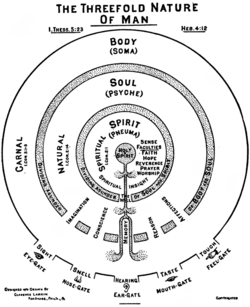The Threefold Nature of Man
Appearance

Click on headings to expand them, or links to go to specific articles.
William Branham copied most of his teaching on the Seven Church Ages, the Seven Seals, and the Future Home from Clarence Larkin. His teaching on the threefold nature of man was also plagiarized from Clarence Larkin.

What William Branham taught:
- the set-up of God’s tabernacle in the wilderness. The first was the congregation, then the holy place then the holiest of holies. That’s God’s house; that’s God’s dwelling place. That’s your dwelling place. Now, you only live in a three room house, remember. You may have two bedrooms; you may have three kitchens, but you only live in a three room house. God lived in a three room House. When God was here on earth, He occupied a three room House, the Soul, Body, and Spirit of Jesus Christ.[1]
- The soul is imagination, conscience, memory, reason, and affection, is the senses or the attributes, like the senses of the soul.[2]
Clarence Larkin
Clarence Larkin stated that:
- ...man is a Trinity, and is composed of “Body,” “Soul,” and “Spirit.” Man was made in the “Image of God” and God is a Trinity.
- The Tabernacle and its Courtyard is a type of the “Threefold Nature of Man.” The “Courtyard” represents his Body, the “Holy Place” his Soul, and the “Most Holy Place” his Spirit, and as there could be no communication between the “Courtyard” and the “Most Holy Place,” only through the “Holy Place,” so there can be no communication between a man’s Body and Spirit only through his Soul.
- The outer circle stands for the “Body” of man, the middle for the “Soul,” and the inner for the “Spirit,” or what Paul calls the “CARNAL” (1 Cor. 3:1–3); the “NATURAL” (1 Cor. 2:14); and the “SPIRITUAL” (1 Cor. 3:1), parts of man. In the outer circle the “Body” is shown as touching the Material World through the five senses of “Sight,” “Smell,” “Hearing,” “Taste” and “Touch.” The Gates to the “Soul” are “Imagination,” “Conscience,” “Memory,” “Reason” and the “Affections.” The “Spirit” receives impressions of outward and material things through the Soul. The “Spiritual Faculties” of the “Spirit” are “Faith,” “Hope,” “Reverence,” “Prayer” and “Worship.”[3]
Footnotes